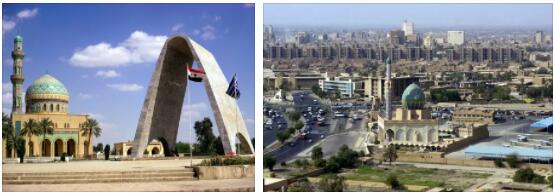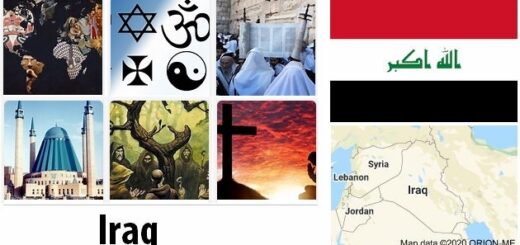History of Iraq
Iraq is located in the interfluve of the Tigris and Euphrates (Greek – Mesopotamia, i.e. interfluve). Mesopotamia was the birthplace of the most ancient world civilizations: the Sumerian-Akkadian (3rd millennium BC), the Babylonian kingdom (21st-6th centuries BC), ancient Assyria (3rd millennium – 7th century BC). BC.). In the 7th-8th centuries. AD Mesopotamia was conquered by the Arabs, Islam came here with them. Mesopotamia became part of the Umayyad and Abbasid caliphates (7th-11th centuries AD). The Turkish sultan Suleiman the Magnificent subjugated all of Mesopotamia in 1534-46, and for almost four centuries it was one of the outskirts of the Ottoman Empire, which collapsed after World War I. Of the three provinces of the former empire – Baghdad, Basra and Mosul – modern Iraq was formed, which, in accordance with the decision of the Supreme Council of the Entente and the mandate of the League of Nations, was ruled by Great Britain in 1920-32. In July 1921, the provisional government of Iraq elected Emir Faisal al-Hashimi as king, but the British high commissioner in Iraq remained the de facto leader of the country. In October 1932, after the cancellation of the mandate, Iraq became formally an independent state and was admitted to the League of Nations. Check equzhou for political system of Iraq.
The mandate regime left a heavy legacy – a backward economy, the omnipotence of feudal lords and usurers in the countryside, the poverty of millions of landless peasants in the countryside and workers, artisans, and the unemployed in the city, serious national and religious contradictions. After gaining independence, the country was ruled by proteges of the British – Prime Minister Nuri Said and Regent under the heir to the throne, Faisal, 2nd Emir Abdul Illah. Their dominance in the country was supported not only by the British, but also by local feudal lords and compradors.
The period after World War II was marked by an upsurge in the national liberation movement. The activity of political parties, which expressed the interests of the working class, the petty bourgeoisie and the national bourgeoisie, increased. Despite the establishment by N. Said of a regime of the most severe dictatorship, resistance to the anti-people policy of the ruling circles grew. The participants in the national liberation movement directed their efforts towards Iraq’s withdrawal from the Baghdad Pact (1955), and in October-November 1956 a powerful wave of demonstrations swept here condemning the aggression of Great Britain, France and Israel against Egypt. The national liberation movement finally took shape in 1957, when the National Unity Front (FNU) was created, which included the Iraqi Communist Party (IKP), the National Democratic Party (NDP), the Ba’ath Party (Iraqi Arab Socialist Renaissance Party – PASV) and the Independence Party. The FNE program provided for the removal of the feudal-monarchist clique from power, the withdrawal of Iraq from the Baghdad Pact and the provision of constitutional democratic freedoms to the population. The program of the Front was approved by the mass patriotic organizations, trade unions, as well as the underground organization “Free Officers”, created in the Iraqi army in May 1956. Check homeagerly for democracy and human rights of Iraq.
The revolution of July 14, 1958, abolished the feudal-monarchist regime. In place of the monarchy, the Republic of Iraq was proclaimed. The first republican government was headed by the leader of the Free Officers organization, which became the vanguard of the armed coup in the capital, Brigadier Abdel Kerim Kasem. During the first year of its existence, the republic achieved significant success in domestic and foreign policy: Iraq withdrew from the Baghdad Pact, liquidated foreign military bases, denounced agreements with the United States on military and economic issues, and restored diplomatic relations with the USSR. In July 1958, the Provisional Constitution was adopted, proclaiming the equality of all citizens before the law, for the first time women were given equal rights with men, the activities of public organizations and trade unions were legalized, and the purge of the state apparatus began.
In September 1958, the agrarian reform law began to be implemented, undermining the foundations of the semi-feudal exploitation of the peasants. In 1959, the Provisional Plan was approved, and in 1961, the first five-year plan for the development of the national economy. In order to reduce its dependence on Western capital, Iraq withdrew from the sterling bloc and established control over the activities of foreign companies, including the multinational Iraq Petroleum Company (IPK). Trade and economic ties were established with the socialist countries, primarily with the USSR. These states began to assist Iraq in the development of the national economy, mainly in the sphere of industry, infrastructure and in the training of national personnel.
In September 1961, the regime of A.K.Kasem started a war against the Kurdish people in the north of the country. This war continued intermittently for 30 years – until 1991. On February 8, 1963, the regime of A.K. Qasem was overthrown as a result of an armed coup organized by the Baath Party, the Arab Nationalist Movement and the military group of Colonel A.S. Aref.
The new supreme body of power, the National Council of Revolutionary Command (NCRC), appointed A.S. Aref as president of the country, but the actual power was in the hands of extremist Ba’ath leaders who occupied key positions in the NCRC and the government. During the first period of being in power (February-November 1963), the PASV manifested itself by the most severe repressions unleashed against the communists and other democratic forces of the country. As a result, approx. 5 thousand people, and more than 10 thousand were thrown into prisons and concentration camps. Almost the entire leadership of the ICP, including its general secretary, Salam Adil, was destroyed.
After the liquidation of its opponents, the Baath regime began in June 1963 a war of extermination against the Kurds, during which the civilian population of Kurdistan was subjected to violence and ill-treatment. The anti-popular political course of the ruling regime, its utter inability to solve the most important problems of the country plunged Iraq into a deep economic crisis. All R. 1963 all political parties and groups that participated in the overthrow of Qasem, refused to ally with the PASV. On November 18, 1963, as a result of a military coup, the Baathists were removed from power. A.S.Aref took over the posts of the President of the country, the Chairman of the NSRK and the Commander-in-Chief. The short period of A.S. Aref’s tenure in power, and after his death in a plane crash in 1966, of his brother, General Abdel Rahman Aref, who previously held the post of chief of the general staff of the Iraqi army, is characterized by a struggle within the ruling bloc. Trying to bring the country out of the crisis, the government expanded cooperation with the UAR, normalized relations with the USSR, and tried to normalize relations with the Kurds. On July 14, 1964, under the influence of supporters of the development of Iraq along the path of the UAR, laws were passed on the nationalization of large enterprises in industry and trade, all banks and insurance companies, including branches of foreign banks and insurance companies. However, in reality, the most important problems related to the democratization of society, the Kurdish issue and the economy have not been resolved. A.R.Aref unsuccessfully tried to maneuver between the various forces of the opposition. On July 17–30, 1968, the Ba’ath Party again came to power in Baghdad, carrying out a coup d’état with the help of the army. A.R. Aref was removed from the presidency. The Revolutionary Command Council (RCC) was established to govern the country.
The activities of the PASV leadership in 1968-2003, which took into account its sad experience of a short reign of the country, can be summarized in several important areas: 1) strengthening the social base of the ruling party; 2) strengthening the financial and economic base for the socio-economic development of the country and for strengthening the stability of the regime; 3) the solution of all remaining major political problems (Kurds, communists, Shiites, the activities of bourgeois and nationalist parties and movements) with the aim of their maximum weakening and neutralization; 4) the creation of an authoritarian regime of personal power of President S. Hussein, who in November 1969 became the second person in the state and the party; 5) expansion of Iraq’s influence in the Middle East, turning the country into a regional superpower.
With the coming to power of the Ba’ath Party, the “Ba’athization” of the officer corps of the army (completed by the beginning of 1970) and all civilian units of the state apparatus began to be carried out. The expansion and renewal of the social base was also carried out at the expense of the working people, the intelligentsia, and university students. The activities of trade unions were placed under the control of the Baath, new Baathist mass organizations were created, as well as “people’s councils” and “people’s army” (armed detachments of the party, personally subordinate to S. Hussein).
In 1972–75, the Ba’ath nationalized the multinational company IPC and its branches in Mosul and Basra. By doing this, she took full control of the main natural wealth of the country – oil. In addition to the foreign policy significance of this move, the nationalization of the IPK led to a huge increase in the power of the PASV due to a sharp increase in world oil prices. In 13 years (1968–80) Iraq’s oil revenues increased almost 55 times, from $476 million to $26.1 billion. This gave the Ba’ath a degree of financial power and independence that none of the previous governments of Iraq had, with a small group of members of the SRC, among whom was the deputy chairman of the SRC, S. Hussein, turned out to be the stewards of finances. With such a solid financial base, the Ba’ath was able to address a number of important social issues related to the improvement of social security, the expansion of free medical care, the creation of one of the most advanced in the 1970s. in the Arab world education system.
In 1970, the Baath invited the ICP to recognize its (Baath) leading role in the government of the country and in the activities of mass organizations. In July 1973, the ICP joined the Progressive National Patriotic Front (PNPF) as a partner of the Baath, depriving itself of the opportunity to publicly criticize the actions of the ruling party. In 1978, when the alliance with the ICP was no longer needed by the Baath (the problems of the Kurds and the nationalization of the “IPK” were practically resolved), S. Hussein declared the communists of Iraq to be foreign agents, repressions were launched against them, 31 communist officers were executed. The IKP was forced to go underground, and the PPPF practically disintegrated. The problem of the Kurds was “resolved” by the adoption of the law of March 11, 1974 on Kurdish autonomy. Such a “solution” did not suit the Kurds of Iraq at all. In Iraqi Kurdistan, ethnic cleansing began – instead of Kurds, Arabs from the southern regions were resettled in the north of the country. In the 2nd floor. 1970s From Iraqi Kurdistan, St. 700 thousand people, destroyed from 1975 to 1988 approx. 4 thousand Kurdish villages.
With rigidity, the problem of Shiites was also “resolved”. In March 1980, several tens of thousands of Iraqi Shiites of Iranian origin were deported to Iran. In the same year, on the orders of S. Hussein, the spiritual head of the Shiites of Iraq, Ayatollah Muhammad Bakr al-Sadr, and his sister were executed. Before these events in the 1970s. Shiites were brutally suppressed in the south of the country.
In July 1979, S. Hussein completely seized power in the country, depriving President A.Kh. al-Bakr of all posts. S. Hussein’s real and potential competitors were shot – a third of the members of the SRK. Only those who were able to unquestioningly obey their leader were left alive.
In order to strengthen the power of Iraq in the region and his own influence in 1980, S. Hussein unleashed a war with Iran, which lasted 8 years. During the war, Iraq lost approx. 200 thousand people and more ok. 300,000 were injured, and the external debt amounted to $80 billion.
In August 1990, S. Hussein unleashed a new war – against Kuwait, declaring it the 19th province of his country. This led to military operations of the multinational forces of 33 countries against Iraq in January-February 1991. An economic blockade was established against Iraq by the decision of the UN Security Council, which lasted until April 2003. During the blockade, St. 1.5 million Iraqis.
In recent years, the US authorities have demanded from the leadership of Iraq to allow UN inspectors, who were expelled from this country in 1998, to check the presence or absence of weapons of mass destruction (WMD) or equipment for their production in Iraq. Iraq has consistently refused these demands. After a series of warnings against Iraq from the United States, on March 18, 2003, US President D. Bush in an ultimatum demanded that S. Hussein leave Iraq within 48 hours. S. Hussein publicly rejected this demand. On the morning of March 20, 2003, D. Bush announced the start of a military operation against Iraq called “Shock and Awe.” The armed forces of the United States, Great Britain and Australia participated in it. During the operation, which lasted 3 weeks, the number of countries participating in the coalition increased to 45.
China, France, the Federal Republic of Germany and India expressed their concern over the start of the war against Iraq. President of the Russian Federation V.V. Putin condemned this military operation. Poland sent troops from European countries to help the US-British coalition. On May 1, 2003, D. Bush announced the end of the war in Iraq. Baghdad was completely captured by US troops on April 9th. The PASW of Iraq was outlawed.
Before the start of the war in the United States, the “Bureau for Reconstruction and Humanitarian Assistance to Iraq” was created, transformed into the Interim Coalition Administration in Iraq. It included 23 ministries. Each is led by an American who has 4 Iraqi consultants. In May 2003, former US State Department official Paul Bremer was appointed as the new head of the Interim Administration. An Iraq Development Fund was established with separate accounts held at the Central Bank of Iraq. Proceeds from the sale of Iraqi oil will have to go to the accounts of the Fund and be distributed until the formation of the government of Iraq by the Interim Administration.
The US plans to transfer power from the Interim Administration to the government of Iraq in 3 stages. Initially, the US military authorities will transfer cities one by one to the administration of the Interim Administration. At the second stage, power will pass into the hands of the Iraqi Interim Administration, in which representatives of the Iraqi opposition will occupy key posts, but on decisive issues the US will have the last word. The third stage involves the adoption of a new Constitution, elections to the Iraqi parliament and the transfer of all power functions to the Iraqis (except for the ministries of internal affairs and defense – they will be transferred to the Iraqis later).
A temporary division of the country into 3 zones (sectors) of responsibility is planned: the USA, Great Britain and Poland. Peacekeepers from other countries are attached to help the peacekeeping contingents of these three states. It is planned to deploy peacekeepers from 23 countries in the Polish sector (including 1,650 from Ukraine, sent in July 2003 to the area of the city of Al-Kut, south of Baghdad).
In August 2003, there were 139,000 US troops in Iraq, 11,000 from the UK and approx. 10 thousand from other 18 states. US military personnel will be present in all zones.
The US Interim Administration allowed local elections to be held in Iraq. In July 2003, the Iraqi Provisional Governing Council (IAC) was formed in Baghdad, consisting of 25 people representing all major groups of the population – Shiites, Sunnis, Kurds, and former secular immigrants. On September 1, 2003, the MCA, in agreement with the Interim Coalition Administration in Iraq, appointed the first cabinet of ministers. The cabinet consists of 25 ministers: 13 Shiites, 5 Sunni Arabs, 5 Sunni Kurds, 1 Turkoman and 1 Assyrian Christian. On June 1, 2004, Sunni Ghazi al Yawar, a member of the WSC since July 2003, was appointed to the presidency of Iraq. Ayyad Alawi, a Shiite member of the Supreme Court of Justice, who founded the Iraqi National Accord movement in exile in 1991, was appointed prime minister.
In August 2003, the recruitment of Iraqi citizens into the new national army began. It is supposed to bring its number up to 40 thousand people. within 3 years. The task is to protect military facilities, power plants, and escort food cargo. The armed detachments of the two leading Kurdish parties – the KDP and the PUK, which, together with the United States, participated in the battles against the army of Saddam Hussein, will eventually join the new Iraqi army.


